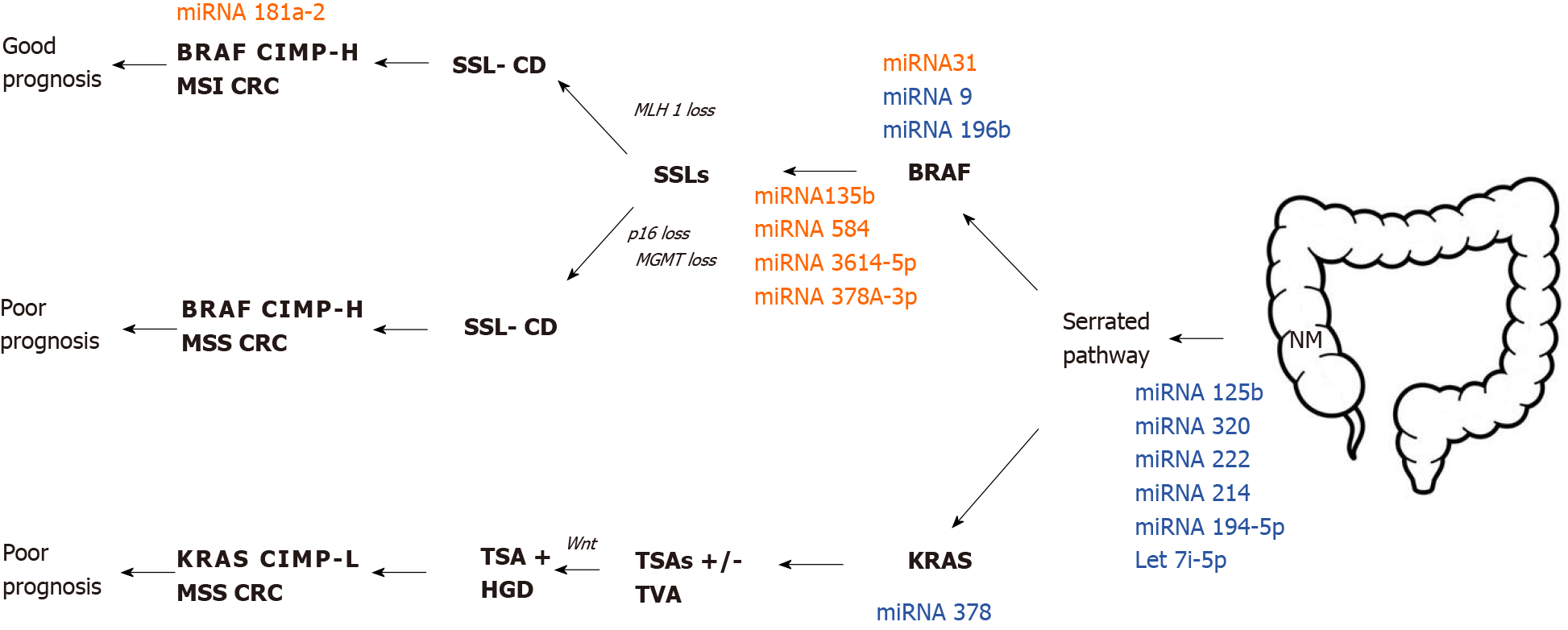Copyright
©The Author(s) 2020.
World J Gastroenterol. Nov 14, 2020; 26(42): 6556-6571
Published online Nov 14, 2020. doi: 10.3748/wjg.v26.i42.6556
Published online Nov 14, 2020. doi: 10.3748/wjg.v26.i42.6556
Figure 1 Schematic presentation of classification of colorectal serrated lesions and polyps.
HP: Hyperplastic polyp; SSL: Sessile serrated lesion; TSA: Traditional serrated adenoma.
Figure 2 Outline of the schematic serrated pathway progression.
In red color we indicate the steps of transformation of BRAF-mutated serrated lesions. BRAF mutations and hypermethylation lead to transformation of aberrant crypt foci to microvesicular hyperplastic polyp then to sessile serrated lesions (SSLs). Methylation and loss of key tumor suppressor genes such as p16 and MLH1 are the key points in SSLs’ progression to serrated adenocarcinoma. In blue color we indicate KRAS mutations in traditional serrated adenomas (TSAs), which showed MGMT hypermethylation, but not MLH1 promoter hypermethylation. In light red shading we indicate a non-MLH1 mutating SSL, which could progress to a TSA and ultimately develop into a BRAF-mutated microsatellite stability tumor. ACF: Aberrant crypt foci; HP: Hyperplastic polyp; SSL: Sessile serrated lesion; SSL-CD: Sessile serrated lesion with cytological dysplasia; TSA: Traditional serrated adenoma; CIMP: CpG island hypermethylator phenotype; CIMP-H: CIMP-high; CIMP-L: CIMP-low; MSI: Microsatellite instability; MSS: Microsatellite stability.
Figure 3 Putative microRNA profile expression in the serrated colorectal pathway.
microRNAs in red color showed up-regulation, while the ones in blue color showed down-regulation. miRNA: microRNA; SSL: Sessile serrated lesion; SSL-CD: Sessile serrated lesion with cytological dysplasia; TSA: Traditional serrated adenoma; HGD-H: High-grade dysplasia; TVA: Tubulovillous adenoma; CIMP: CpG island methylator phenotype; CIMP-H: CIMP-high; CIMP-L: CIMP-low; MSI: Microsatellite instability; MSS: Microsatellite stability; NM: Normal mucosa.
- Citation: Peruhova M, Peshevska-Sekulovska M, Krastev B, Panayotova G, Georgieva V, Konakchieva R, Nikolaev G, Velikova TV. What could microRNA expression tell us more about colorectal serrated pathway carcinogenesis? World J Gastroenterol 2020; 26(42): 6556-6571
- URL: https://www.wjgnet.com/1007-9327/full/v26/i42/6556.htm
- DOI: https://dx.doi.org/10.3748/wjg.v26.i42.6556











